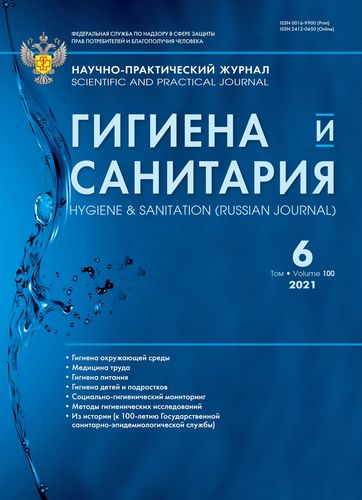Hygienic assessment of the complex of physical and chemical factors affecting a person in rooms of the different purpose in in-patients medical institutions
- Authors: Rusakov N.V.1, Kalinina N.V.1, Gaponova E.B.1, Goshin M.Y.1, Banin I.M.1
-
Affiliations:
- Centre for Strategic Planning and Management of Biomedical Health Risks of the Federal Medical Biological Agency
- Issue: Vol 100, No 6 (2021)
- Pages: 546-554
- Section: ENVIRONMENTAL HYGIENE
- Published: 14.07.2021
- URL: https://rjraap.com/0016-9900/article/view/639256
- DOI: https://doi.org/10.47470/0016-9900-2021-100-6-546-554
- ID: 639256
Cite item
Full Text
Abstract
Introduction. The paper presents the hygienic assessment of the complex physical and chemical factors affecting patients and staff in the different premises of institutional medical organizations.
Material and methods. The comprehensive hygienic assessment of the internal environment of medical institutions was based on three in-patient medical institutions (IMI). The research objects were medical wards, operating rooms, treatment rooms, dressing rooms, physiotherapy rooms, laboratory and diagnostic rooms, utility rooms. The study included measurements of the following parameters: microclimate, noise, electromagnetic fields level in different frequency ranges, ion regime, assessment of natural light, artificial light, insolation, gamma radiation level, measurements of concentrations of carbon dioxide, oxygen, ozone, radon, mercury vapor, and volatile organic compounds.
Results. It is shown that in the hospital environment, a person is affected by complex physical factors. Microclimatic parameters are one of the most significant factors in the hospital environment that require constant monitoring. The control of the given factor is exceptionally substantial in IMI buildings that are not equipped with in-patients an air conditioning system. The highest noise levels were found in physiotherapy rooms and diagnostic rooms. The primary source of noise in medical rooms is working equipment, inwards – conversational speech. Both patients and medical workers were established to receive the main electromagnetic load in diagnostic rooms, laboratory rooms, and physiotherapy rooms. The assessment of the light environment showed that each of the examined rooms was provided with a sufficient level of natural light, and the duration of insolation in the treatment rooms corresponded to hygienic requirements. The highest levels of artificial light were in rooms with led lights. In the air of the examined rooms, light ions of both polarities were either absent, or their content was below the minimum required concentration. Higher concentrations of organic acids and chlorine-containing compounds were found in the surveyed premises of IMO compared to the air in other public buildings. The highest concentration of chemical compounds in the air was observed in wards and diagnostic rooms.
Conclusion. The need for regular monitoring of physical and chemical factors affecting patients and staff in IMI is justified. A list of physical factors for carrying out risk-oriented control in hospital premises, taking into account their functional purpose, is required.
About the authors
Nikolay V. Rusakov
Centre for Strategic Planning and Management of Biomedical Health Risks of the Federal Medical Biological Agency
Author for correspondence.
Email: noemail@neicon.ru
ORCID iD: 0000-0002-3754-009X
Russian Federation
Natalia V. Kalinina
Centre for Strategic Planning and Management of Biomedical Health Risks of the Federal Medical Biological Agency
Email: nkalinina@cspmz.ru
ORCID iD: 0000-0001-8444-9662
MD, Ph.D., leading researcher, Department of environmental hygiene, Centre for Strategic Planning and Management of Biomedical Health Risks of the Federal Medical Biological Agency, Moscow, 119121, Russian Federation.
e-mail: NKalinina@cspmz.ru
Russian FederationElena B. Gaponova
Centre for Strategic Planning and Management of Biomedical Health Risks of the Federal Medical Biological Agency
Email: noemail@neicon.ru
ORCID iD: 0000-0001-9259-0009
Russian Federation
Mikhail Ye. Goshin
Centre for Strategic Planning and Management of Biomedical Health Risks of the Federal Medical Biological Agency
Email: noemail@neicon.ru
ORCID iD: 0000-0001-7251-3938
Russian Federation
Ilya M. Banin
Centre for Strategic Planning and Management of Biomedical Health Risks of the Federal Medical Biological Agency
Email: noemail@neicon.ru
ORCID iD: 0000-0001-9467-8485
Russian Federation
References
- Shcherbo A.P. Hospital Hygiene [Bol‘nichnaya gigiena]. St. Petersburg; 2000. (in Russian)
- Znamenskiy A.V. Hospital hygiene: sanitary and epidemiological requirements for the construction and operation of medical institutions. St. Petersburg: Foliant; 2004. (in Russian)
- Voyffen V., Oberdester F., Kramer A. Hospital Hygiene: Hygiene of Health Care Institutions [Bol’nichnaya gigiena: gigiena uchrezhdeniy zdravookhraneniya]. Minsk: Belarus’; 1984. (in Russian)
- Kirillov R.P. Occupational Health of Surgical Doctors [Gigiena truda vrachey khirurgicheskogo profilya]. Moscow: Meditsina; 1982. (in Russian)
- Izmerov N.F. Labor and Health of Physicians [Trud i zdorov’e medikov]. Moscow: Real’noe vremya; 2005. (in Russian)
- Fedina N.V. A problem of physicians’ occupational risk and quality of life. Zdravookhranenie v Rossiyskoy Federatsii. 2008; 52(6): 27–30. (in Russian)
- Dubel’ E.V., Unguryanu T.N. Hygienic assessment of working conditions for medical personnel in clinical and paraclinical departments of the hospital. Gigiena i Sanitaria (Hygiene and Sanitation, Russian journal). 2016; 95(1): 53–7. https://doi.org/10.18821/0016-99002016-95-1-53-57 (in Russian)
- Skipetrov V.P. Aeroions and Life [Aeroiony i zhizn’]. Saransk: Krasnyy Oktyabr’; 2011: 50–136. (in Russian)
- Lysenko A.V., Tayutina T.V., Nedoruba E.A. Impact assessment of the degree of ionization of the air environment on the functional state of the organism of athletes. Sovremennye problemy nauki i obrazovaniya. 2014; (2): 252–4. (in Russian)
- Posokhin I.I., Lobanov D.V. Recovery of air environment of a room by air ozonation and air ionization. Nauchnyy vestnik Voronezhskogo gosudarstvennogo arkhitekturno-stroitel’nogo universiteta. Seriya: Vysokie tekhnologii. 2012; (1): 15–20. (in Russian)
Supplementary files









